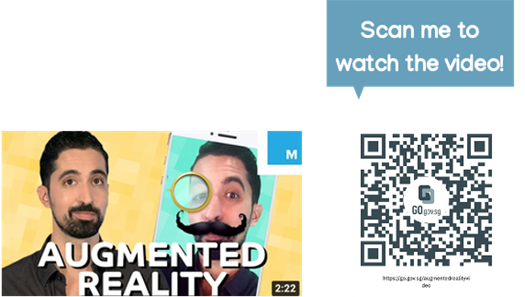That's Not My Zebra's Colours
By: Fiona Watt, Rachel Wells & Non Figg
Publisher:London: Usborne, 2018
DiscoverTech
discovereads

For more digital preschool resources, please click here!
[Updated October 2024]
Let's Learn About Binary Code
Suitable for 4 to 6 years old

What is Binary Code?
Computers use a language called binary code to understand things. The binary code system is represented by two digits – 0 and 1. It is difficult for humans to understand binary code so we use programmes that are closer to human languages.
Binary Code Spelling
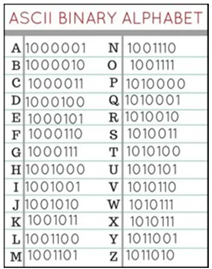
Source: Unplugged coding activities for kids. (2021, March 15). Discover Coding. https://www.discovercoding.ca/unplugged-coding-activities-for-kids/
Materials needed
1. ASCII Alphabet Table (download here or refer to image above)
2. Pencil
How to play:
Use the ASCII Binary Alphabet Table to spell the following words:
1. READ
R= _ _ _ _ _ _ _
E= _ _ _ _ _ _ _
A= _ _ _ _ _ _ _
D= _ _ _ _ _ _ _
2. LIBRARY
L=_ _ _ _ _ _ _
I= _ _ _ _ _ _ _
B=_ _ _ _ _ _ _
R=_ _ _ _ _ _ _
A=_ _ _ _ _ _ _
R=_ _ _ _ _ _ _
Y=_ _ _ _ _ _ _
3. BOOK
B=_ _ _ _ _ _ _
O=_ _ _ _ _ _ _
O=_ _ _ _ _ _ _
K=_ _ _ _ _ _ _
4. CODING
C=_ _ _ _ _ _ _
O=_ _ _ _ _ _ _
D=_ _ _ _ _ _ _
I=_ _ _ _ _ _ _
N=_ _ _ _ _ _ _
G=_ _ _ _ _ _ _
You may also challenge your child to spell other words in binary code!
Parent’s Pro-tip
Humans use a dictionary to translate a language that we do not understand to one that we understand. Similarly, for computers, they use a complier to translate high level language such as Python, in words into binary code.
Binary Scavenger Hunt

Materials needed:
1. A list of items spelt in binary code (download here for a sample of list of items)
2. ASCII Alphabet Table (download here or refer to image above)
How to play:
1. Get your child to translate the scavenger hunt items
2. Find the items
Parent’s Pro Tip
Share with your child that ASCII stands for American Standard Code for Information Interchange. It is a global standard of text representation in binary code. The table used in this activity is the Standard ASCII which uses 7-bit binary numbers.
Source: Rosenthal, C. (2022, July 24). Binary Code Projects. STEAM Powered Family. Retrieved October 2, 2022, from https://www.steampoweredfamily.com/binary-code-projects/
Let's Watch!
Coding for Preschoolers: What is Binary Code? (2.09 min)
Obot and Robot Coach Susie explain how to talk to computers in binary code.
Let's Read
1. Code Academy and the Code Confusion

By: Kirsty Holmes
Publisher: King's Lynn, Norfolk: BookLife Publishing, 2019
2. What Are Binary and Hexadecimal Numbers

By: Patricia Harris
Publisher: New York: PowerKids Press, 2018
3. How Computers Work

By: Steffi Cavell-Clarke & Thomas Welch
Publisher: New York, NY: KidHaven Publishing, an imprint of Greenhaven Publishing, LLC, 2019
4. Machines That Think!
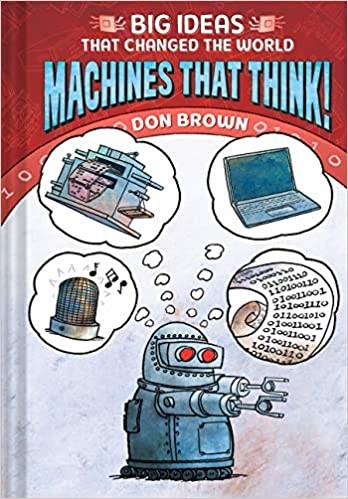
By: Don Brown
Publisher: New York: Amulet Books, 2020
Link: https://nlb.overdrive.com/media/5404336
All book covers are copyright of the respective publishing companies.
Let’s Learn About Digital Art!
Suitable for 4 to 6 years old

What is Digital Art?
These days art isn't limited to paper and colour pencils. Digital Art uses technology like tablets or laptops to create images. You can draw your favourite storybook character or tasty treats. With certain apps, your images can even move!
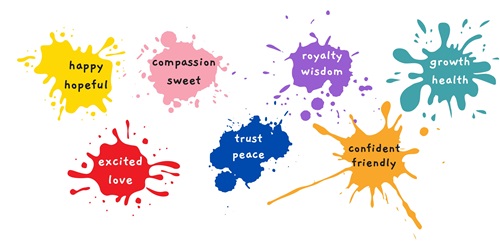
Colours are so important. They are one of the first ways a toddler learns, understands and describes objects they see. Another method of arranging visual information is through shapes. Letting your child explore different shapes helps with their observational skills too.
Colours Activity
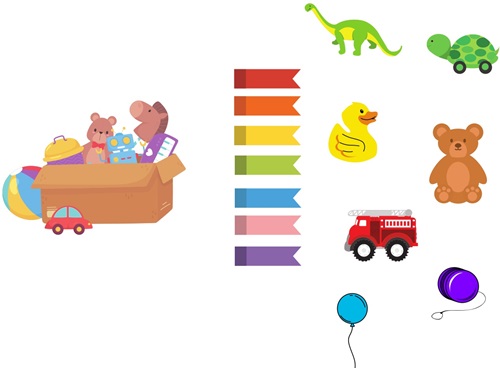
How to Play
Find colourful items and place them in a basket or box. Next, place coloured paper in front of the basket and have your child sort the objects.
Parents' Pro Tip
This wonderful activity helps your child develop skills in making comparisons as well as their organisation. As your child plays, they will classify and sort items based on their similarities.
Poulpe the Octopus’ Birthday Party!

Materials Needed
-
Colour Pencils
-
Paint
-
Crayons
How To Play
Decorate Poulpe and her home in time for her party. Practice your math by figuring out which number corresponds
to which colour. Be as creative as you can with the colours. You can even draw objects in the
background.
Activity Sheet for Octopus Birthday Party!
Parents’ Pro Tip
The background with no numbers is a chance for your child to draw and colour freely! If your child gets stuck on what to draw or write, have some visual references handy. Use your fingers to count with your child and have them do the same. If they run into a mistake, don't tell them if they're wrong. Encourage them to try again.
Let's Watch!
13 Toddler Activities for Learning You Can Do At Home | 1-2 year olds I butfirstcoffeeblog.com (12.33min)
Great and colorful educational crafts and DIYs for toddlers. Learn colors and numbers with these awesome crafts for kids!
Let’s Read!

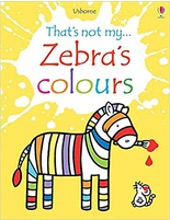

Finding Beauty
By:Talitha Shipman
Publisher:Minneapolis, MN: Beaming Books, 2021

Art and Photos wih ScratchJr
Publisher:New York: PowerKids Press, 2022
All book covers are copyright of the respective publishing companies.
Let’s Learn About Positive Digital Habits!
Suitable for 4 to 6 years old

Help Your Child Develop Positive Digital Habits
The American Academy of Pediatrics with support from the Media Literacy Council recommend that parents limit
screen time (games, computers, tablets, smartphones and televisions) for preschoolers 2-5 years old to at most 1
hour per day.
Toddlers 1-2 years old should be getting little to no screen time.
Your children should watch high-quality programming - which means it’s got to be educational and
interactive!
Bonding Activity
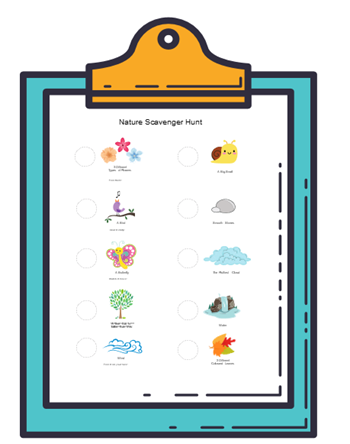
It’s good to get away from technology, and what better way than to have a wonderful sensory scavenger hunt in nature? What treasures can you find?
Instructions
Pack your gear:
-
Bring a pencil to tick the treasures you find.
-
Remember to bring a water bottle.
-
Have fun outside!
Parents, please take pictures of your children while they are out and about.
Reflection
Talk to your child about their scavenger hunt.
-
Which item was their favourite to find?
-
Which was the most difficult thing to find?
-
What senses did they use on their hunt?
Parents’ Pro Tip
If you find something interesting that is not on the list, have your child write or draw it on the activity sheet!
Unlock your Phone!
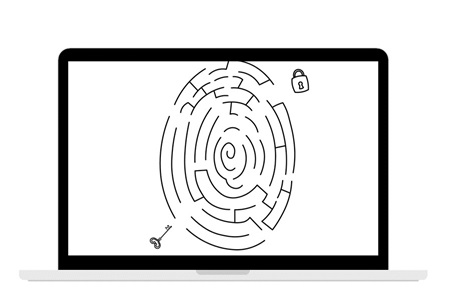
Have your ever taken a look at your hand? At the tips of your fingers are your own unique prints. That means no one else has the same whorls and loops like you do. Our fingerprints also protect the privacy of your parents' phones.
Instructions
-
Try tracing a line from the key to the lock through the maze.
-
There are a few ways to unlock your phone.
Parents’ Pro Tip
Collaborate with your child. Encourage them to tell you how they would solve the activity. If they run into a mistake, don't tell them if they're wrong. Ask if what they're doing is the best way.
Activity: What are we hiding?
Bai the Book wants to read with his friends and family at the playground.
Can you figure out where they are hiding?
Instructions
Circle the books you find.


Let's Watch!
Controlling screen time can be tricky, because screens are everywhere. According to some big health organizations we should probably be paying more attention to the effects screen time can have on kids, especially the little ones under the age of 5.
Let’s Read!
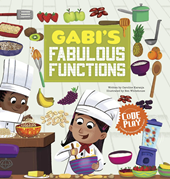
Gabi's Fabulous Functions
By: Caroline Karanja & Ben Whitehouse
Publisher:North Mankato, Minnesota: Picture Window
Books, 2018

My Animal Atlas: 270 Amazing Animals and Where They Live
Author:Nastja Holtfreter
Publisher:Baltimore, MD: Duo Press, 2021

The Wild World Handbook: Habitats
By:Andrea Debbink & Asia Orlando
Publisher: Philadelphia: Quirk Books, 2021
All book covers are copyright of the respective publishing companies.
Let’s Learn About Augmented Reality!
Suitable for 4 to 6 years old

Augmented Reality (AR) “augments” your experience of the world around you. Augment means "to add". Virtual objects are added to our environment. AR combines our real world with the virtual world to make our reality better and more interesting!
Animals Come Alive! Activity

Materials Needed
-
"ABC Animals, Alphabet in Motion" book by Sarina Simon (see "Book Recommendations")
-
A digital device
-
The "ABC Animals AR" app by North South Studios, available free on IOS and Android
How to Play
Use the app alongside the book, and discover adorable animals with your child, while helping them learn the alphabet! Read the book aloud with your child and ask them the questions on the page related to each letter and animal. Then, point your device at the photographs in the book and watch as the still images on the page magically transform into motion videos, revealing the answers to the questions asked.
Parents’ Pro Tip
Read the books below with your child one time first without using the AR apps. Let them get familiar with the characters and the storyline before introducing the app to them. They might get too distracted with the app by then to focus on the story! This will also allow them to fully appreciate how the added use of AR elevates their reading experience.
Stories Come Alive!


Materials Needed
-
Arbi and the Fire Breathing Dragon" by Iker Burguera (see "Book Recommendations")
-
A digital device
-
The “Arbi Augmented Reality” app by Educa Reality, available free on IOS and Android
How to Play
Read the book with your child while using the app. Not only will you be able to watch the story come alive on
your device, but you will also get to answer pop quiz questions too!
Encourage your child to get curious and interact freely with the 3D elements in the book. Play around with the
camera angles. Zoom in and zoom out. Fold and rotate the pages. Tilt the book back and forth. The possibilities
are endless!
You can even do a fun photoshoot with your child! Take some photos of your child posing with some of the AR
animations. Let them express themselves and get creative with the poses!
Activity Sheet for Stories Come Alive!
Parents’ Pro Tip
Take some time to introduce the app to your child first and walk them through how they can use it. You can be the one using it initially for the first few pages of the book before letting them have a go later once they have observed you do so.
Let's Watch!
A short and entertaining video explaining what Augmented Reality actually is and providing us with real life examples of the use of AR today.
Let’s Read!

Rainy Weather: A 4D Book
Author: Sally Lee
Publisher:North Mankato, Minnesota: Pebble, a
Capstone imprint, 2018

Curious Pearl Tinkers with Simple Machines
Author:Eric Braun
Publisher:North Mankato, Minnesota: Picture Window
Books, 2019


ABC Animals: Alphabet in Motion
Author:Sarina Simon
Publisher: Los Angeles, California : NorthSouth
Studios LLC, 2016

Arbi and the Fire Breathing Dragon
Author:Iker Burguera
Publisher:United States : CreateSpace, 2015

Arbi and the Treasure Chest
Author: Iker Burguera
Publisher: United States: Createspace, 2016
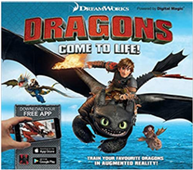
Dragons Come to Life!
Author:Emily Stead
Publisher:London: Carlton Books Limited, 2017
All book covers are copyright of the respective publishing companies.
Let’s Learn About Sequences!
Suitable for 4 to 6 years old

Doing things in the correct sequence is important. A programmer needs to teach computers or robots to do things
in the correct order.
For example, you should wash your vegetables before cooking them. If you wash them after cooking, you will end
up eating soggy food!
Building Block Sequencing Activity

Materials Needed
-
26 Building Blocks such as Lego Duplo
-
Alphabet Stickers or Erasable Markers
How to Play
Paste the each letter of the alphabet sticker on the side of the building blocks (or use the marker to write the letters). Stack the blocks in alphabetical order and remove one (or two). Get your child to find out which one is missing.
Parents’ Pro Tip
Introduce your child to the alphabet before trying the activity. For older children, you can use the blocks to spell simple words. Remove 1 letter from a word and have your child figure out which is the missing letter! You may need to add more blocks as some words such as "eggs" repeat the same letter.
Robot, Brush your Teeth!

Materials Needed
-
Activity sheet provided below.
-
Printed arrows (optional)
How to Play
Your robot friend, Ida is not afraid of water and wants to learn how to brush her teeth!
Teach Ida to brush her teeth by numbering the steps below correctly from 1 to 5.
You can also cut out the jigsaw pieces and fit them together in the correct order!
Activity Sheet for Robot, Brush Your Teeth!
Parents’ Pro Tip
Create similar activities for your child by breaking down other daily tasks (such as wearing shoes) into smaller steps and asking your child to rearrange them in the right order!
Let's Watch!
Sequencing focuses on the order of things. Learn about how a computer needs to have correct step-by-step instructions with this fun sequencing coding song.
Let’s Read!

Nerdycorn
Author: Andrew Root
Publisher:New York : Beach Lane Books, 2021

Sequences: Order Matters!
Author:Nadia Higgins
Publisher:North Mankato, MN : Cantata Learning,
2018
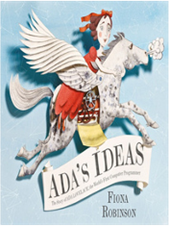
Ada's Ideas : The Story of Ada Lovelace, the World's First Computer Programmer
Author:Fiona Robinson
Publisher: New York : Abrams Books for Young
Readers, 2016
All book covers are copyright of the respective publishing companies.
Let’s Learn About Decomposition!
Suitable for 4 to 6 years old

Decomposition is breaking down a computing task or problem into smaller parts so that it becomes easier.
Share with your child that decomposition occurs in daily activities such as brushing one's teeth, reading a book
and making breakfast. All of these can be broken down into smaller steps.
Sandwich Robot Activity

Materials Needed
-
A few slices of bread
-
Any of your child's favourite sandwich fillings- cheese, tomatoes, lettuce, jam, butter, sliced meat etc. which are already available at home
-
Plastic knife
-
Plate
How to Play
Get your child to be a Sandwich Robot and you will be the Computer Programmer. Start by giving step-by-step instructions (decomposition) to your Robot on how to construct a yummy sandwich. Keep the steps short and clear. If your Robot gets it wrong- for example, doing too much, too little, or the wrong thing -- tell them, Stop! Robot Malfunction! Keep going until you have a finished sandwich, served on a plate and ready to eat!
Parents’ Pro Tip
Before the activity, explain to your child that robots need very specific and step by step instructions
to
execute the task correctly even if it seems obvious to us.
To illustrate this, you can use an everyday routine that your child is familiar with such as brushing
their
teeth.
To brush our teeth, we would need to:
1. Pick up the toothbrush, wet it and add toothpaste on it
2. Brush your teeth
3. Rinse your mouth with water
4. Wash your toothbrush and you are done!
Blast Off, Rocket Ship!

Materials Needed
-
Activity sheet provided below.
-
Coloured paper or foam sheets cut into basic shapes in different sizes (optional)
How to Play
1. Break down, or decompose, the rocket ship below. Can you identify all the different shapes found on
the
rocket ship?
2. Can you identify the missing parts of the rocket ship?
Activity Sheet for Blast Off, Rocket Ship!
Parents’ Pro Tip
Talk about shapes and colours with your child before trying out this activity.
For a hands-on approach, you can cut out the shapes needed to make the rocket ship from coloured foam
sheets and
build the rocket ship with your child.
Let's Watch!
Coding for Kids | What is coding for kids? | Coding for beginners | Understanding Coding | Coding Words (3:17 mins)
This video contains simple information for children to understand how conditional statements work in programming.
Let’s Read!

Code Academy and The Code Confusion!
Author: Kirsty Holmes
Publisher:King's Lynn, Norfolk, BookLife
Publishing, 2019

Ava in Code Land
Author:Jess Hitchman & Gavin
Cullen
Publisher:New York : Feiwel and Friends,
2020

Breaking Down Tasks : Using Decomposition
Author:Elizabeth Schmermund
Publisher: New York : Cavendish Square,
2018

Gabi's Fabulous Functions
Author:Caroline Karanja
Publisher:North Mankato, Minnesota :
Picture Window
Books, 2018

Algorithms & Sequencing
Author: Teddy Borth
Publisher: Minneapolis, Minnesota : Pop!, a
division of ABDO, 2022
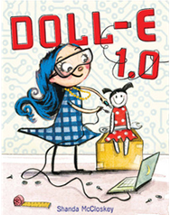
Doll-E 1.0
Author:Shanda McCloskey
Publisher:New York : Little, Brown and
Company,
2018
All book covers are copyright of the respective publishing companies.
Let’s Learn About Algorithm!
Suitable for 4 to 6 years old

An algorithm is a set of steps to follow in order to complete a task or solve a problem.
In coding, algorithms provide step-by-step instructions for computer programmes to complete various
tasks such
as calculations or processing data.
Egg Carton Coding Activity

Materials Needed
-
Egg cartons
-
Plastics eggs or any items that can hold the small prizes
-
Small prizes for the eggs
-
Your child's favourite miniature toy
-
Red construction paper
How to Play
Get the miniature toy to the prize eggs while avoiding the lava rocks. Plan the algorithms and move the miniature toy to all the prize eggs. If the toy lands on a lava rock, go back to the start and debug the algorithm!
Parents’ Pro Tip
Introduce your child to the concept of directions before you try the activities below. Get them to "walk" the algorithm by following a set of instructions which include directional words. For instance, take two steps to the right. This will help them to understand the orientation of an algorithm.
Escape the Bear!
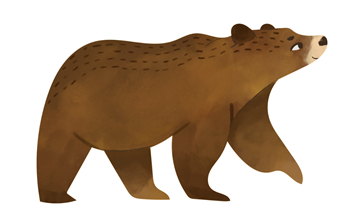
Materials Needed
-
Activity sheet provided below.
-
Printed arrows (optional)
How to Play
Help the family escape from the big, brown bear and reach home as fast as they can. Avoid the obstacles along the way! Challenge yourself to create different sets of algorithms by using directional signs - up, down, right and left.
Activity Sheet for Escape the Bear!
Parents’ Pro Tip
Have fun reading the story of "We're Going on a Bear Hunt" by Michael Rosen. Introduce the
concept of
sequencing
as your guide your child to remember the seuuence of obstacles met!
Recall the concept of directions, to plan the algorithm to escape!
Let's Watch!
Watch this video to find out more about Algorithm through the example of brushing your teeth!
Let’s Read!

Algorithms: Solve A Problem!
Author: Blake Hoena, Sr. Sanchez
& Mark
Mallman
Publisher:North Mankato, MN:
Cantata
Learning, 2018

Algorithms & Sequencing
Author:Teddy Borth
Publisher:Minneapolis, Minnesota:
Pop!, a
division
of ABD, 2020

Coding, 1, 2, 3
Author:Janet Slingerland
Publisher:North Mankato, Minnesota:
Rourke
Eudcational Media, 2019

You Can’t Dance to These Rhythms. What Are Algorithms?
Author:Brian P. Cleary & Martin
Goneau
Publisher:Minnesota, MN: Millbrook
Press,
2019
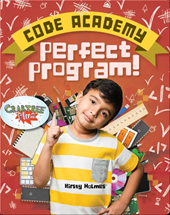

Dot. Unplugged
Author:Randi Zuckerberg
Publisher:London: Walker
Entertainment,
2020
All book covers are copyright of the respective publishing companies.
Let’s Learn About Looping!
Suitable for 4 to 6 years old
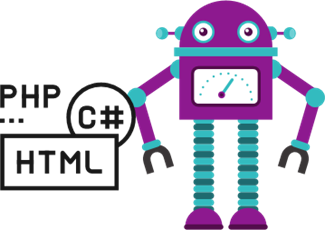
Looping is about doing something again and again and again.
When you need to repeat something in code, you can use a loop. Looping allows you to repeat an
action
again
without having to write the same instructions over and over again.
Yoga Looping Activity

Materials Needed
-
A piece of paper
-
Writing materials
How to Play
Together with your child, come up with a Yoga regime! Follow the steps below.
-
Scan the QR code above to view some yoga poses. Decide with your child which yoga poses both of you would like to do and list them down on a paper.
-
Next to each yoga pose you have decided, decide how many times you would want to do it (looping!).
-
Follow the sequence of the poses and loops of the yoga poses on your list. Enjoy your yoga!
Parents’ Pro Tip
Coding teaches children to take risks, to be creative, to solve problems, to persevere, to think critically and logic, to be focused and to be confident. Get started with unplugged coding activities such as building your own board game, creating a maze or playing treasure hunt with your child at home. Scan the QR code below for more ideas on unplugged coding activities.

Loop that Sandcastle

Materials Needed
-
Activity sheet provided below.
-
Pencil or crayon
How to Play
In the storybook "How to Code a Sandcastle", Pearl and Pascal coded an entire kingdom with 3 instructions on a repeat mode.
-
Fill the pail with sand.
-
Dump the sand on our spot.
-
Pat the sand down.
Count the number of loops Pascal did to create each sandcastle and write it in the box.
Activity Sheet for Loop That Sandcastle
Parents’ Pro Tip
Use coding-related language often.
To teach looping concepts at home, instead of telling your child to "do that again and again",
say
"repeat that 5 times".
That's the way we tell computers to loop a certain action in coding languages too.
Let's Watch!
A loop is a command used to repeat a part of a code until a desired process is complete. Watch this video to find out more on why loops are important in programming.
Let’s Read!

How to Code a Rollercoaster
Author: Josh Funk & Sara
Palacios
Publisher:New York : Viking, 2019

I Can Code : If/Then
Author:Vicky Fang & Jade
Orlando
Publisher:Naperville, Illinois :
Sourcebooks
eXplore, 2020

Baby Loves Coding!
Author:Ruth Spiro & Irene
Chan
Publisher:Watertown, MA :
Charlesbridge,
2018
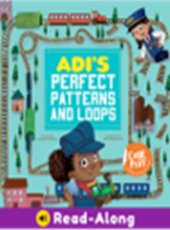
Adi’s Perfect Patterns and Loops
Author:Caroline Karanja & Ben
Whitehouse
Publisher:North Mankato, Minnesota
:
Picture Window
Books, 2018

How to Code a Sandcastle
Author:Josh Funk & Sara
Palacios
Publisher: New York, New York :
Viking,
2018

Loops: Repeat, repeat!
Author:Patricia M. Stockland
Publisher:North Mankato, MN :
Cantata
Learning,
2018
All book covers are copyright of the respective publishing companies.
Let’s Learn About Branching!
Suitable for 4 to 6 years old

Branching, also known as decision making, equips us with choices in the instructions. There are some conditions that dictate what happens.
If/Then Backyard Activity

Materials Needed
• A wide space safe from hazards
• A set of instructions
How to Play
This game requires a "programmer" and some "computers". The "programmer" stands in front of the "computers" and gives instructions for example, " if i turn in a circle, then you turn in a circle" or he/she can give more challenging instructions, like, "if I touch my nose, then you touch your legs."
Take turns with your family members to be "programmer" and "computers".
Parents’ Pro Tip
Introduce your child to the concept of following rules before you try the activity below. Share with them examples of rules and why we need to follow them. Inform them that this activity requires them to listen carefully to instructions and only do the actions that they are required to. This can help your child to practise coordination between their body parts.
Branching with Crunch the Dinosaur
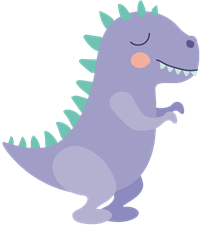
Materials Needed
Activity sheet provided below.
How to Play
Interactive picture books, such as "Crunch, the Shy Dinosaur" gives children an idea on if/then conditional statements, as they do the actions narrated in the book and see what happens to the character. Match an if/then statement by drawing a line to connect the two pictures.
Activity Sheet for Branching with Crunch the Dinosaur
Parents’ Pro Tip
Branching can be easily understood by using any picture book. Read a story with your child. After the story, test your child's memory of the story by asking them questions, like, "if duck quacks loudly..." and get your child to answer," then the other animals will get angry!" You can even recreate the story with your child.
Let's Watch!
This video contains simple information for children to understand how conditional statements work in programming.
Let’s Read!

ScratchJr Coding Cards
Author: Marina Umaschi Bers
Publisher:New York : No Starch
Press, 2020

I Can Code : If/Then
Author:Vicky Fang
Publisher:Naperville, Illinois :
Sourcebooks
eXplore, 2020

The Couch Potato
Author:Jory John
Publisher:New York : HarperCollins,
2020

Rox’s Secret Code
Author:Mara Lecocq
Publisher:New York : POW! Kids
Books, 2021

Gabi's If/Then Garden
Author:Caroline Karanja
Publisher: North Mankato : Picture
Window
Books,
2018

Coding 1,2,3
Author:Janet Slingerland
Publisher:Vero Beach : Rourke
Educational
Media,
2018
All book covers are copyright of the respective publishing companies.
Let’s Learn About Debugging!
Suitable for 4 to 6 years old

Computer bugs are errors in computer programmes which can cause computers or apps to crash.
Some common computer bugs include misspellings, wrong numbers, repeated and wrongly-sequenced instructions.
To ensure that the programmes run correctly, programmers will fix these bugs step by step in a process called debugging.
Treasure Hunt

Materials Needed
• A few toys or any safe household items to be hidden around the house.
• A few sets of correct and buggy algorithm (make them fun!)
How to Play
Hide a few toys or any safe household items around the house. Prepare one set of correct and buggy algorithm for each of the hidden item. Have your child draw the algorithm randomly and follow it to discover the treasure. If your child gets the buggy algorithm, get them to debug it after they have followed the algorithm!
Parents’ Pro Tip
Introduce your child to the concept of directions before you try the activity below. Get them to "walk" the algorithm by following a set of instructions which include directional words. For instance, take two steps to the right. This will help them to understand the orientation of an algorithm.
Catch the Bugs!

Materials Needed
Activity sheet provided below.
How to Play
Spot and circle the “bug” in the following series of patterns.
Activity Sheet for Catch the Bugs!
Parents’ Pro Tip
Read books and sing nursery rhymes that have repetition! This helps your child to recognize patterns and make predictions. Allow your child to repeat the phrases or rhymes in the books and songs and challenge them to predict what happens in the story or continue the song on their own.
Let's Watch!
Coding for Kids |What is coding for kids? | Coding for beginners | Types of Coding |Coding Languages (3:35 mins)
The video summarises what coding is all about and introduces children to the different types of coding languages and methods.
Let's Read!

How Coding Works
Author: Ben Hubbard
Publisher: Oxford: Raintree, 2017

Debugging: You Can Fix It!
Author: Patricia M. Stockland
Publisher: Cantata Learning, 2020

Bugs That Make Your Computer Crawl
Author: Brian P. Cleary
Publisher: Lerner Publishing Group,
2019

Coding 1, 2, 3
Author: Janet Slingerland
Publisher: Rourke Educational
Media, 2020

You Can’t Dance to These Rhythms
Author: Brian p. Cleary
Publisher: Lerner Publishing Group,
2019
All book covers are copyright of the respective publishing companies.




